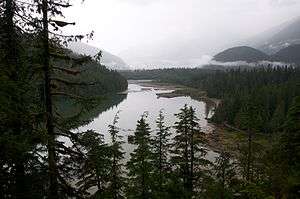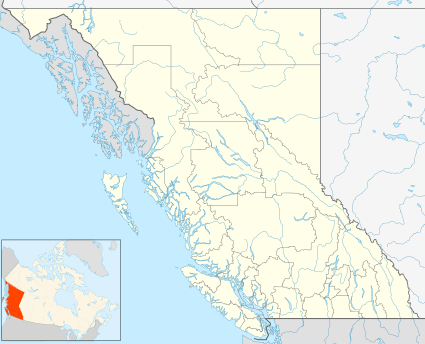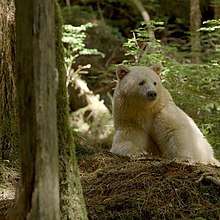Great Bear Rainforest
The Great Bear Rainforest (also known as the Central and North Coast forest)[2][3] is a temperate rain forest on the Pacific coast of British Columbia, Canada comprising 6.4 million hectares.[4] It is part of the larger Pacific temperate rainforest ecoregion, which is the largest coastal temperate rainforest in the world.[3][5]
| Great Bear Rainforest | |
|---|---|
 A view of Kitlope Lake in the Kitlope Heritage Conservancy. | |
| Geography | |
 | |
| Coordinates | 53°00′00″N 128°00′00″W[1] |
| Area | 6,400,000 hectares (16,000,000 acres) |
| Established | 19 May 2016 |
The Great Bear Rainforest was officially recognized by the Government of British Columbia in February 2016, when it announced an agreement to permanently protect 85% of the old-growth forested area from industrial logging.[5][6] The forest was admitted to the Queen's Commonwealth Canopy in September of the same year.
Geography
The size of the Great Bear Rainforest, also called the North and Central Coast land use planning area or the Central and North Coast LRMP area, is roughly 32,000 km2 (12,000 sq mi).[7] As part of the 2006 North and Central Coast Land Use Decision three new land use zones were created: Protected Areas; Biodiversity, Mining, and Tourism Areas (BMTAs); and Ecosystem-based Management Operating Areas (EBMs). As of 2009, approximately 16,000 km2 (6,200 sq mi) of the region has been designated as protected areas (in a form called conservancies[8]), and 3,000 km2 (1,200 sq mi) as BMTAs. Commercial timber harvesting and commercial hydro-electric power projects are prohibited within BMTAs.[9][10]
The Great Bear Rainforest extends from the Discovery Islands in the south to the BC-Alaska boundary in the north, it includes all offshore islands within this range except Vancouver Island and the archipelago of Haida Gwaii[1]. Its northern end reaches up Portland Canal to the vicinity of Stewart. To the south it includes Prince Rupert, most of Douglas Channel, half of Hawkesbury Island, and part of Gardner Canal. Kitimat is outside the region, to the east. Farther south, the region includes all of the coast west and south of the Fiordland Conservancy, Kitlope Heritage Conservancy Protected Area, Tweedsmuir North and Tweedsmuir South Provincial Parks—which includes Dean Channel, Burke Channel, Rivers Inlet, and the communities of Bella Bella, Bella Coola, and Hagensborg. The southern end of the region includes Knight Inlet and Bute Inlet.[11][12]
Ecology

The Great Bear Rainforest is one of the largest remaining tracts of unspoiled temperate rainforest left in the world.[13] The area is home to species such as cougars, wolves, salmon, grizzly bears, and the Kermode ("spirit") bear, a unique subspecies of the black bear, in which one in ten cubs displays a recessive white coloured coat.
The forest features 1,000-year-old western red cedar and 90-metre Sitka spruce.[14]
Coastal temperate rainforests are characterized by their proximity to both ocean and mountains. Abundant rainfall results when the atmospheric flow of moist air off the ocean collides with mountain ranges. Much of the Pacific coastline of North America shares this climate pattern, including portions of Alaska, British Columbia, Washington, Oregon, and Northern California.
History
Campaign for protection
In the early 1990s environmentalists launched a large scale campaign to protect the Clayoquot Sound region of Vancouver Island. After years of conflict the British Columbia government announced a ban on clear-cutting in the Clayoquot rainforests and began a local planning process that incorporated First Nations of the area and independent scientists.[15] The Clayoquot Sound campaign became the model for the Great Bear Rainforest campaign. Techniques used at Clayoquot Sound were further developed and new approaches adopted, such as international marketing campaigns, improved mapping technologies, and the use of large-scale holistic ecosystem-based management models.[15] In 1997 the central and northern BC coastal region was renamed "Great Bear Rainforest" by a network of ENGOs (environmental nongovernmental organizations), including Greenpeace, Sierra Club BC, Pacific Wild, and Stand.earth, for the purpose of galvanizing an international campaign for its protection. The name, which was chosen without consulting local residents, was by 2005 being used by many organizations, including news media outlets. As Maureen Gail Reed writes, "the emotive significance of such a name cannot be underestimated".[16]
In May 2004, after years of conflict and negotiation, the various stakeholders agreed to recommend the BC government that about 3,500,000 acres (14,000 km2), about 33% of the Great Bear Rainforest, be put under some form of protection, and that new forms of ecosystem-based forestry be required throughout the rainforest. This fell short of the scientific recommendations, which had concluded that 44%–70% should be protected. The recommendation given to the BC government was a compromise solution agreed to by the many stakeholders after years of difficult negotiations.[17] The stakeholders include provincial and local governments; many BC First Nations such as the Heiltsuk and Homalco; the ENGOs Greenpeace, ForestEthics, Rainforest Action Network, Pacific Wild, and Sierra Club BC; and forestry corporations such as Canadian Forest Products, Catalyst Paper Corporation, International Forest Products, Western Forest Products; and many others.[18]
On 7 February 2006 a comprehensive protection package was announced for the Great Bear Rainforest, which was defined to include the central and north coasts of BC and Haida Gwaii (Queen Charlotte Islands). The Great Bear Rainforest Agreement included four key elements: rainforest protection, improved logging practices, the involvement of First Nations in decision making, and conservation financing to enable economic diversification. The final agreement banned logging in 33% of the Great Bear Rainforest and made a commitment to implement ecosystem-based forestry management for the entire Great Bear Rainforest by 2009.[17]
The 2006 agreement between the BC government and a wide coalition of conservationists, loggers, hunters, and First Nations established a series of conservancies stretching 400 kilometres (250 mi) along the coast.[19] The proposed protected areas will contain 18,000 square kilometres (6,900 sq mi), and another 46,900 square kilometres (18,100 sq mi) that is to be run under a management plan that is expected to ensure sustainable forest management.[19]
The Canadian government announced on 21 January 2007 that it will spend CAD$30m for protection of this rainforest. This matches a pledge made previously by the British Columbia provincial government, as well as private donations of $60 million, making the total funding for the new reserve $120 million.[20]
In the autumn of 2008, Greenpeace, Sierra Club BC and ForestEthics (jointly known as Rainforest Solutions Project) launched an online campaign titled, "Keep the Promise," to put public pressure on Gordon Campbell, then Premier of British Columbia, to honour the Great Bear Rainforest agreement in its entirety. The groups were concerned certain aspects of the agreement, including implementation of ecosystem-based management (EBM), would not materialize in time for the government's own final implementation deadline of March 31, 2009.[21]
Government recognition and protection
On February 1, 2016, Premier Christy Clark announced an agreement had been reached between the province of British Columbia, First Nations, environmentalists and the forestry industry to protect 85% of the 6.4 million hectare Great Bear Rainforest from industrial logging.[5][6] The remaining 15% would still be subject to logging under stringent conditions. The agreement also recognizes aboriginal rights to shared decision-making, and provides a greater economic share of timber rights and $15-million in funding to 26 First Nations in the area.[5][22][23]
The Great Bear Rainforest (Forest Management) Act was introduced by the government on March 1, 2016.[24] In September, Prince William, Duke of Cambridge, and Catherine, Duchess of Cambridge, visited and unveiled a plaque in the forest acknowledging its admission into the Queen's Commonwealth Canopy.[25]
Fuel spill

In October of 2016, a tugboat hauling a barge which held approximately 200,000 litres of industrial oils including diesel, ran hard aground at Seaforth Channel[26][27] near the Heiltsuk Nation and the Great Bear Rainforest.[28]
References
- "Great Bear Rainforest". BC Geographical Names.
- "Great Bear Rainforest". British Columbia Integrated Land Management Bureau. Retrieved 2016-11-15.
- "Great Bear Rainforest (formerly Coast Land Use Decision Implementation)". British Columbia Integrated Land Management Bureau. Retrieved 2016-11-15.
- "Legislation supports innovative forest management in Great Bear Rainforest". Government of British Columbia. 1 March 2016. Retrieved 1 March 2016.
- Hunter, Justine (1 February 2016). "Final agreement reached to protect B.C.'s Great Bear Rainforest". The Globe and Mail. Retrieved 2 February 2016.
- Morrow, Fiona (1 February 2016). "Great Bear Rainforest agreement creates 'a gift to the world'". CBC News. Retrieved 2 February 2016.
- http://www.harbourpublishing.com/title/TheGreatBearRainforest
- "Conservancies". BC Parks. Archived from the original on 2010-03-23. Retrieved 28 October 2011.
- "EBM Protects Coastal Jobs, Culture and Environment" (PDF). BC Integrated Land Management Bureau. Retrieved 28 October 2011.
- "Central and North Coast EBM Implementation - Biodiversity, Mining and Tourism Areas". British Columbia Ministry of Natural Resource Operations. Archived from the original on 25 April 2012. Retrieved 28 October 2011.
- "Map of Conservancies and Biodiversity Mining and Tourism Areas" (PDF). BC Integrated Land Management Bureau. Archived from the original (PDF) on 13 May 2012. Retrieved 28 October 2011.
- "Map of Land and Resource Management Plan (LRMP) boundary" (PDF). BC Integrated Land Management Bureau. Archived from the original (PDF) on 19 May 2012. Retrieved 28 October 2011.
- "Great Bear Rainforest". Living Oceans Society. June 8, 2011. Retrieved June 8, 2011.
- "Great Bear Rainforest". Greenpeace. July 10, 2003. Archived from the original on December 2, 2008. Retrieved February 25, 2009.
- Esbjörn-Hargens, Sean; Zimmerman, Michael E. (2009). Integral ecology: uniting multiple perspectives on the natural world. Shambhala Publications. pp. 459–461. ISBN 978-1-59030-466-2. Retrieved 18 July 2011.
- Reed, Maureen Gail (2004). Taking stands: gender and the sustainability of rural communities. UBC Press. pp. 19, 33. ISBN 978-0-7748-1018-0. Retrieved 18 July 2011.
- Esbjörn-Hargens, Sean; Zimmerman, Michael E. (2009). Integral ecology: uniting multiple perspectives on the natural world. Shambhala Publications. p. 471. ISBN 978-1-59030-466-2. Retrieved 18 July 2011.
- "Province announces a new vision for coastal B.C." British Columbia Ministry of Agriculture and Lands. Retrieved 28 October 2011.
- Struck, Doug (2006-02-07). "Huge Canadian Park Is Born of Compromise". Washington Post. Archived from the original on 2010-01-26. Retrieved 2010-01-25.
- "Canada acts to protect rainforest". BBC News Online. January 22, 2007. Retrieved September 18, 2008.
- "Environmentalist turns to online campaign to protect B.C. forest". CBC News. November 28, 2008. Retrieved December 3, 2009.
- "Coast Land Use Decision Implementation". BC Strategic Land and Resource Planning. Retrieved 2016-11-15.
- "Proposed 2015 Great Bear Rainforest Order and Potential Biodiversity, Mining and Tourism Areas / Conservancy Designations". BC Strategic Land and Resource Planning. Retrieved 2016-11-15.
- "B.C. legislation to halt logging in much of Great Bear Rainforest". The Globe and Mail. 1 March 2016. Retrieved 1 March 2016.
- "Royals endorse Great Bear Rainforest as part of Queen's Commonwealth Canopy". CBC. September 26, 2016. Retrieved September 26, 2016.
- "8 am Situation Report – Oct 23", Spill Response BC, October 23, 2016, archived from the original on November 25, 2016, retrieved November 24, 2016
- Lindsay, Bethany (October 14, 2016). "Diesel fears after tug and petroleum barge run aground near Bella Bella". Vancouver Sun. Retrieved November 24, 2016.
- Zada, John (November 16, 2016). "Canadian First Nation cleans up latest fuel spill mess: Fuel spill in Canada's Great Bear Rainforest adds to pressure to cut fuel transport lines on Pacific Coast". British Columbia: Al Jazeera. Retrieved November 24, 2016.
Further reading
- DellaSala, Dominick (2010). Temperate and Boreal Rainforests of the World: Ecology and Conservation. Island Press. pp. 60–64. ISBN 978-1-59726-676-5. Retrieved 18 July 2011.
- Hanna, Kevin Stuart; Clark, Douglas A. (2007). Transforming parks and protected areas: policy and governance in a changing world. Psychology Press. pp. 145–147. ISBN 978-0-415-37423-1. Retrieved 18 July 2011.
External links
- "North and Central Coast Protected Area Planning". BC Parks.
- Take It Taller: Save The Great Bear Rainforest
- "Coast Forest Region". BC Ministry of Forests, Lands and Natural Resource Operations.